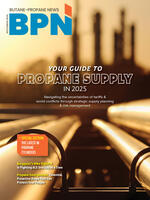
The coffee cups between us are already half-empty, a little steam still curling from the surface. Outside, morning light spills across the diner’s parking lot, catching the chrome of passing cars. A server swings by with the easy rhythm of someone who’s worked here forever, refilling our mugs without asking.
We’ve been talking about other things: board meetings, travel schedules, a side comment about whether the grilled cheese here has changed in 20 years; though, today it’s eggs and toast, when I tilt my head and say, “So, New Jersey wants a bigger voice.”
I’ve been in propane just four years. Long enough to have a solid grasp of the industry, but still learning the deeper currents. Across from me sits Rich Van Orden, three decades in — the kind of person who’s navigated these waters more times than he can count.
I’ve learned more from these casual conversations than from any manual or webinar. Half the time, I’m still scribbling notes long after he’s switched topics.
Rich grins, setting his spoon down. “Not just New Jersey. Every state wants a bigger voice. But wanting it is one thing. Earning it is another.”
I tap my finger against my mug. “Earning it, how? I mean, we have a strong presence already.”
“That’s true,” he says, leaning back. “But earning it means proving we’re not just reactive. It’s about being in the room early and shaping the conversation before it shapes us. It’s easy to show up when something’s already in your backyard. It’s harder to be there before the problem even starts.”
That’s the gap I’m still learning to bridge: how to pinpoint the next problem before anyone else sees it coming.
I frown. “Like that hearing where half the people didn’t realize they were talking about LPG [liquefied petroleum gas], not LNG [liquefied natural gas]?”
He points at me, eyes bright. “I know. They weren’t just a little misinformed; they were on the wrong field entirely. And if we’re not there to fix that, the wrong story sticks. We can’t assume people know the difference.”
I used to think everyone in energy understood these distinctions. Turns out, sometimes I’m the one asking the most basic questions, and Rich never makes me feel foolish for it.
I take some home fries from the plate between us. “So, the ‘bigger voice’ isn’t just being louder; it’s educating before the damage is done.”
“Right,” he says with a small grin, sliding the plate a little closer. “And we also need to show our own industry walking the talk. Which isn’t always happening.”
I nod. “Like high-volume operations where diesel’s dominance isn’t as necessary.”
“That’s a perfect example,” he says, leaning forward. “In some fleets, propane can replace diesel without sacrificing performance, all while cutting emissions and improving safety. And it’s not just theory; it’s happening.”
I picture the first time he walked me through one of these case studies — pages of numbers I barely grasped and how he translated them into something I could explain to the board the next day.
I sip my coffee. “But here’s the challenge: Most marketers aren’t in a position to research incentives or push a project like that on their own. They’re running their businesses.”
“That’s where the New Jersey Propane Gas Association [NJPGA] comes in,” he says, pausing to butter his toast. “We watch the legislative landscape, track incentive programs and then we connect members with the right resources so they can make the most of them.”
“We can put the opportunity in front of them,” I add, “and walk them through the requirements. The company still decides if they want to take that step, but at least they’ve got a clear path.
“And in New Jersey,” I continue, “that’s even more important because we’ve had an administration that’s been all-in on electric only. No energy choice.”
“Yep,” he says between bites. “We have to push for that seat at the table. And we have to push with data, not just opinion. Show the emissions numbers. Show the cost savings. Show resilience. That’s how you shift a conversation in a tough political climate.”
The server returns with a fresh pot, the coffee splashing slightly onto the table. Rich thanks her and wraps his hands around the mug like he’s gathering a thought. This is where my learning curve shows. I tend to lead with the human story, then back into the data. Rich does both in one breath.
“You know what opens people up?” I say. “Not just charts. A concrete example they can picture. At that school bus meeting last year, we were going nowhere until we mentioned that one district had switched to propane and cut costs. Everyone sat up. If we want propane to gain ground, we also have to be seen using it ourselves and making opportunities easy for others in the industry to follow.”
I scoop another bite of the home fries we’ve been sharing, pausing for a moment. “Renewable propane was another one I didn’t get at first. I thought it was some far-off dream. Thanks for walking me through that one, too, a while ago. Now I know it’s here.”
Rich leans back slightly, listening, and I can see him weighing how much to unpack at once. “Made from waste fats, used cooking oils, ag byproducts — people can picture that. And it drops right into existing systems, no new equipment. Marketers sometimes think it’s replacing traditional propane, but it’s not. It’s an evolution and a business opportunity.”
I’m still catching up on the science, but the idea that something so future-facing works with what’s already in place feels like a golden ticket.
“And how it looks matters,” I say. “People in the school bus industry have said to me, ‘Why convert to propane if your own industry doesn’t power its own vehicles with it?’”
“Truth is,” he says, “a bobtail isn’t designed to run entirely on propane. Diesel still makes sense in some heavy-duty applications. But we are seeing propane-powered vehicles in high-profile places, and in the right balance, propane can even fill the gaps where electric systems fall short, especially in cold climates, rural areas, or during outages, or even moving a lot of cargo.”
“That includes some major port operations,” I say.
“Right,” Rich explains. “Newark’s port just put 20 propane-powered terminal tractors into service. Ninety-nine percent less nitrogen oxide than diesel. Almost no particulate matter. No drop in performance. It’s not for show. It’s lowering emissions, improving safety for workers and it saves money long term.”
“And that’s the kind of example that moves the needle with skeptics,” I say, “especially when it comes from a trusted operation. If I had to boil it down, I’d say meet people where they are. Whether they’re worried about cost, climate or reliability, speak their language first.”
“And use plain language — no acronyms unless you explain them,” Rich says. He starts ticking off points with his fingers. “One, propane’s role in resilience. Two, how it works when the grid goes down. Three, how it’s cleaner than diesel and heating oil. And four, how it’s affordable and reliable for rural areas.”
He explains it slowly, the way you do when you want each point to land. It’s not the first time he’s explained them, but he treats it like it matters every time.
I tuck that list away like a mental checklist. I’m still adding to it every time we talk. Some points I’ve heard before, but hearing them again in a different context makes them click in a new way.
“And don’t forget internal education,” he says. “Our state association, other states, the Propane Education & Research Council [PERC], the National Propane Gas Association [NPGA] — we’ve got resources, talking points, case studies, side-by-side comparisons. If our marketers aren’t equipped, the message dies before it leaves the building.”
“One thing I’ve learned at NPGA’s Propane Days,” I say, “is that NPGA has you covered to help you talk with legislators. It’s up to us not to wait until there’s a bill on the floor to introduce ourselves to a legislator, though. It could be too late by then.”
“Exactly,” he says. “Relationships happen before the hearings start. Invite them for a site visit at a marketer’s facility. Show them the safety measures, the innovation. We’ve had great success in New Jersey with open houses for public officials and fleet managers in the past. When they know you and trust you, they’ll listen when it counts.”
That’s one of those truths I’ve seen play out over and over, but I still need the reminder, especially when my calendar is already packed. “We need more of them, though,” I say.
“We need marketers to open their doors for these public-facing representatives.”
“So, you keep bringing it up. You keep putting the thought in front of them,” Rich says.
The check lands on the table, but neither of us moves for it. I glance at my watch, then back at Rich.
“So, if someone asked me what we’re doing here in this conversation, in this article, I’d say we’re making sure people don’t just hear about propane — they understand it.”
He nods, finishing his coffee. “And that starts with us leading the conversation. Not waiting for those skeptics to come around shutting us down, but showing them, first, with facts, and with proof.”
“And a little humility,” I interject.
“Yes, of course,” he says. “We show up with facts, proof and humility: that propane — both the traditional and the renewable options — delivers cleaner, more resilient energy today.”
I smile. “And maybe, if they’re lucky, they’ll get a booth like this and a plate of home fries while we tell them about it.”
“That’s the plan,” he says.
For further resources on effectively positioning propane for success, take a look at BPN's Strategy section.


